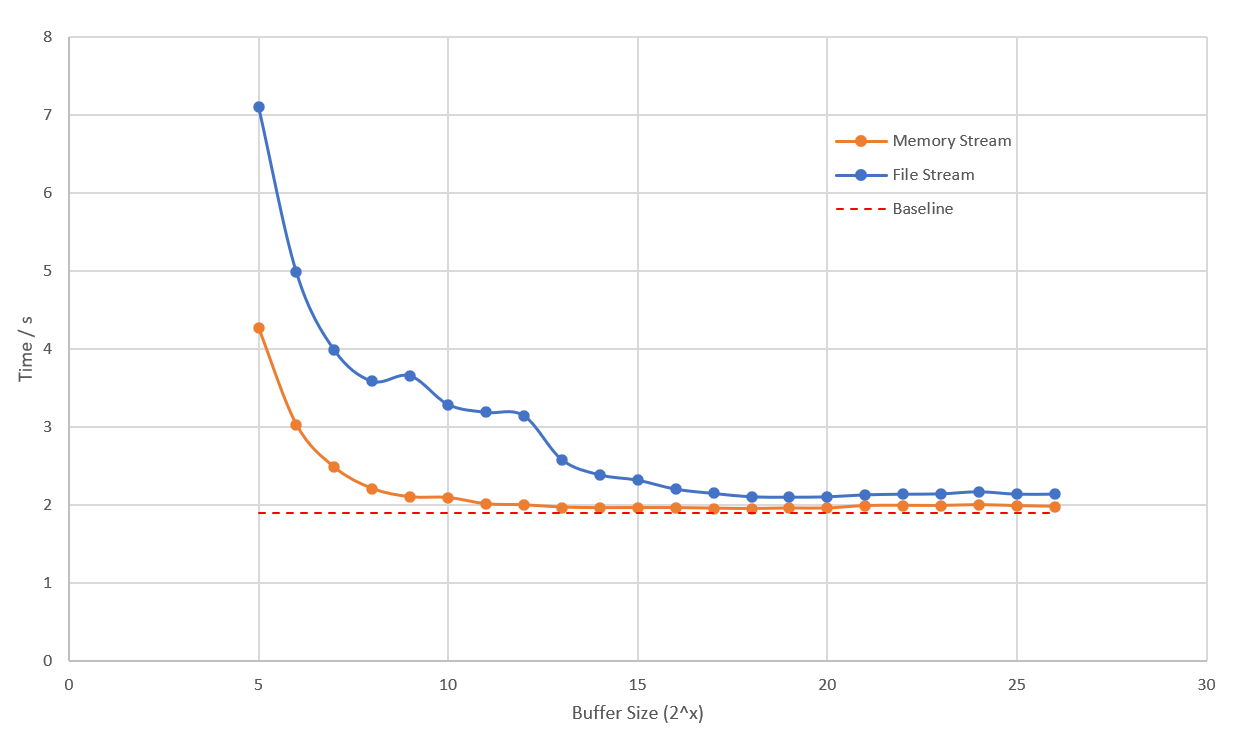最*需要在计算大文件的 MD5 值时显示进度,于是我写了如下的代码:
public long Length {get; private set; }
public long Position { get; private set; }
public async Task ComputeMD5Async(string file, CancellationToken cancellationToken)
{
using var fs = File.OpenRead(file);
Length = fs.Length;
var task = MD5.HashDataAsync(fs, cancellationToken);
var timer = new PeriodicTimer(TimeSpan.FromMilliseconds(10));
while (await timer.WaitForNextTickAsync(cancellationToken))
{
Position = fs.Position;
if (task.IsCompleted)
{
break;
}
}
}
运行的时候发现不对劲儿了,我的校验速度只能跑到 350MB/s,而别人的却能跑到 500MB/s,相同的设备怎么差距有这么大?带这个疑问我去看了看别人的源码,发现是这么写的:
protected long _progressPerFileSizeCurrent;
protected byte[] CheckHash(Stream stream, HashAlgorithm hashProvider, CancellationToken token)
{
byte[] buffer = new byte[1 << 20];
int read;
while ((read = stream.Read(buffer)) > 0)
{
token.ThrowIfCancellationRequested();
hashProvider.TransformBlock(buffer, 0, read, buffer, 0);
_progressPerFileSizeCurrent += read;
}
hashProvider.TransformFinalBlock(buffer, 0, read);
return hashProvider.Hash;
}
这里使用了 HashAlgorithm.TransformBlock 方法,它能计算输入字节数组指定区域的哈希值,并将中间结果暂时存储起来,最后再调用 HashAlgorithm.TransformFinalBlock 结束计算。上述代码中缓冲区 buffer 大小是 1MB,我敏锐地察觉到 MD5 计算速度可能与这个值有关,接着我又去翻了翻 MD5.HashDataAsync 的源码。
// System.Security.Cryptography.LiteHashProvider
private static async ValueTask<int> ProcessStreamAsync<T>(T hash, Stream source, Memory<byte> destination, CancellationToken cancellationToken) where T : ILiteHash
{
using (hash)
{
byte[] rented = CryptoPool.Rent(4096);
int maxRead = 0;
int read;
try
{
while ((read = await source.ReadAsync(rented, cancellationToken).ConfigureAwait(false)) > 0)
{
maxRead = Math.Max(maxRead, read);
hash.Append(rented.AsSpan(0, read));
}
return hash.Finalize(destination.Span);
}
finally
{
CryptoPool.Return(rented, clearSize: maxRead);
}
}
}
源码中最关键的是上面这部分,缓冲区 rented 设置为 4KB,与 1MB 相差甚远,原因有可能就在这里。
为了找到最佳的缓冲区值,我跑了一大堆 BenchMark,覆盖了从 32B 到 64MB 的范围。没什么技术含量,但工作量实在不小。测试使用 1GB 的文件,基准测试是对 1GB 大小的数组直接调用 MD5.HashData,实际的测试代码如下,分别使用内存流 MemoryStream 和文件流 FileStream 作为入参 Stream,对比无硬盘 IO 和实际读取文件的速度。
public async Task HashDataAsync(Stream stream)
{
var hash = MD5.Create();
byte[] buffer = new byte[1 << size];
int read = 0;
while ((read = await stream.ReadAsync(buffer)) != 0)
{
hash.TransformBlock(buffer, 0, read, buffer, 0);
}
hash.TransformFinalBlock(buffer, 0, read);
if (!(hash.Hash?.SequenceEqual(fileHash) ?? false))
{
throw new Exception("Compute error");
}
}
基准测试是那条红色虚线,是所有测试结果中最快的。橙色的曲线是 MemoryStream 的测试结果,在缓存块的 2KB 处降到了一个较低的位置,后续耗时无明显下降。这证明 .NET 源码中使用 4KB 大小的块是一个合理的选择,但是它没有考虑文件 IO 的延迟影响。蓝色的曲线是最接*显示的测试结果,缓存块大于 32KB 时的测试结果才接*于*稳。
总结一下,MD5.HashDataAsync 过慢的原因是文件 IO 影响到了计算速度。使用文件流进行 MD5 校验的时候,缓冲区至少需要 64KB,总体速度才不会被文件 IO 拖后腿。
